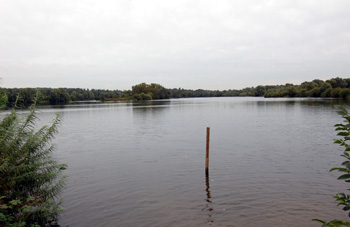Odell Romano-British Farmstead

The site of the Romano-British farmstead September 2008
The best known Romano-British site in Odell now lies beneath the lake in Harrold-Odell Country Park. The site was a gravel pit operated by Hall Aggregates and was excavated from 1974 until 1978 by a team under Brian Dix, who wrote his preliminary report in Bedfordshire Archaeology Volume 14 in 1980.
The site also comprised prehistoric elements including possible Neolithic features and a Bronze Age ring ditch. A Bronze Age grave was found within the area defined by the ditch and had been disturbed by a ditch dug in the 1st century AD.
The farmstead itself began a generation or so before the Roman Conquest (43 AD) and so just falls into the Iron Age, a time when the population seems to have expanded and so moved into previously unoccupied sites. The initial settlement was based on a roughly rectangular enclosure about forty metres wide in the south-west corner of a large field and contained two round houses, each ten to twelve metres in diameter. One of these had a large pottery vessel set into a water filled pit and was interpreted as a cold store. The settlement seems to have been first enclosed by a timber palisade, which was later replaced by a series of ditches. A number of small arable fields led off from the settlement itself. The main stockyard seems to have been to the west as indicated by a number of ditched enclosures interpreted as corrals for animals. In one of the numerous wells on teh site the remains of a wooden plough were discovered.
Just beyond the farmstead lay two cremation cemeteries, one dated to the period 25 to 50 AD. Five pits each contained human remains. Mixed pig bones indicated ritual offerings to the dead. The other cemetery, fufty seven square metres in extent, appeared to be earlier and comprised six cremations in urns.
At the end of the 1st century AD, the area now being under Roman rule, the homestead moved to the south, closer to the river, to an area which had previously been used for animal pens. This new settlement comprised a number of circular and rectangular buildings and was not enclosed by a palisade. This site was occupied for a long time and successive rebuilding and new building made it difficult to estimate the size of the settlement at any one time. The final building was a rectangular farmhouse containing several rooms and occupying an area some fourteen metres by twenty eight metres. It was probably abandoned towards the end of the 4th century.
South of this settlement lay a farmyard and two stone-lined wells which were dug in the 2nd century and later a drying kiln was constructed, built of local limestone. The farming practice seems to have continued unchanged from that followed at the time the farmstead was first established - a mixture of arable farming and stock rearing.
The site seems to have been abandoned from the mid to late 4th century for around three hundred years. It was then reoccupied to some extent as evidenced by two wicker-lined wells.